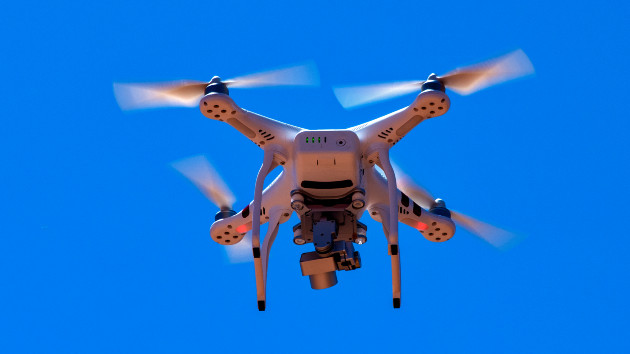(NEW YORK) — Near the end of the third quarter of last week’s NFL game between the Baltimore Ravens and Cincinnati Bengals, play was stopped because there was an object with flashing red and green lights hovering over the field.
That object was a drone, and it is illegal to fly over sporting events without prior permission, according to the Federal Aviation Administration, which said it is investigating the incident.
While there are many benefits of drones, countering potentially malicious drones falls under the purview of the Department of Homeland Security, according to Samantha Vinograd, who serves as DHS’ assistant secretary for counterterrorism and threat prevention.
“We are concerned by rapidly-evolving technology associated with drones, and that they can be used for a variety of malicious purposes,” Vinograd told ABC News in an interview.
She said the national airspace is “saturated” with drones and “a lot of malicious actors also recognize the benefits that drones can provide.”
“We have seen an explosion in drone activity in the national airspace just from a volume perspective, and that is because drones are really cheap to make and technology is really available and evolving rapidly,” she said.
The users of the drones are sometimes people who don’t realize they are flying in a restricted area, Vinograd said.
“Sometimes these drones are recreational users that lose control of their drones, [but] that doesn’t mean that they’re not at risk,” she said. “Other times, it could be malicious.”
The department wants to ensure “every community has the ability to detect and mitigate drone activity responsibly in line with the same safeguards that we’re already employing at the federal level,” she said, noting that DHS “can’t be everywhere. It’s just not possible.”
For the large-scale events, like the presidential inauguration and the Super Bowl, the department is on scene helping with drone mitigation.
But DHS’ concerns stretch beyond these large-scale events to considerations such as routine presidential protection, the southern border and airport security.
Vinograd said agents along the southern border have encountered and disrupted drones that were flying over with contraband or enabling human trafficking.
DHS’ drone countermeasures were extended until February by Congress, but Vinograd is asking Congress not only to reauthorize the countermeasures, but also expand them to include the ability for the Transportation Security Administration to mitigate drones.
At airports, the TSA has encountered 600 drones since 2018, underscoring the need for more robust security measures, according to Vinograd.
“TSA does not have the authority to proactively detect and mitigate drones,” she said. “There are countless drone incidents in and around major airports every year. We’ve had actual commercial flights disrupted because of drone activity. We had ground stops.”
Between January and July of this year, there were 302 drone incidents occurring near an airport and 146 near Core 30 airports, which are the largest airports in the country. In six of those cases, airplanes had to divert to avoid hitting the drone, Vinograd said.
If DHS doesn’t have its program reauthorized in February, it could be bad for the country’s national security, she said.
“Think about if DHS lost the ability for the most part to protect the president and vice president,” she said. “What if DHS lost the ability to mitigate drone activity at the southwest border when there are drones carrying fentanyl and our officers just had to watch them? What if DHS lost the ability to counter drone activity in and around the New York City Marathon? That’s a terrifying concept.”
Copyright © 2023, ABC Audio. All rights reserved.












